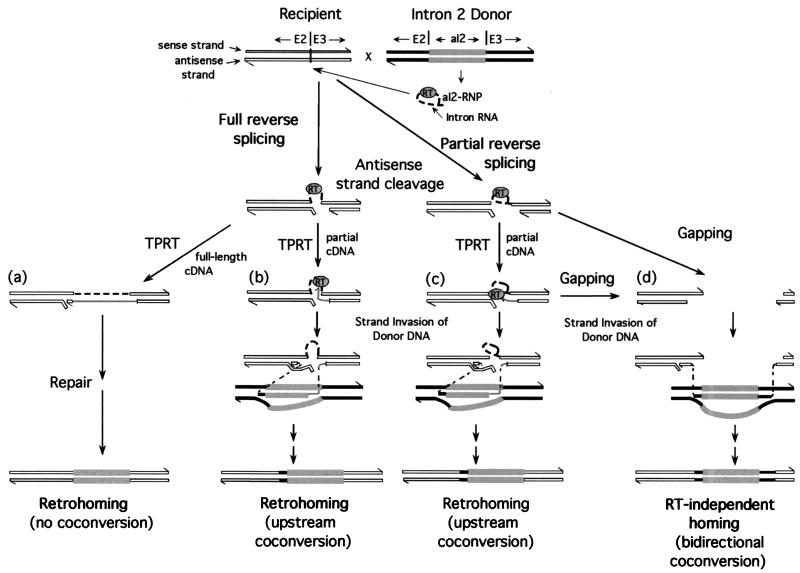FIG. 6.
Different pathways used for aI2 homing. The diagram summarizes features of the aI2 homing pathways analyzed in this study. The donor and recipient alleles are shown in the first line. Sense and antisense strands of the donor and recipient DNAs are identified, and the strand polarity is indicated by half arrowheads at the 3′ ends. White strands indicate recipient DNA exons, black strands indicate donor DNA exons, and thick gray strands indicate intron DNA. The donor strain synthesizes aI2 RNP particles containing excised intron RNA (thick dashed lines) and the intron-encoded RT protein. Homing is initiated by partial or full reverse splicing into the aI2 DNA target site. The next line shows the products of partial and full reverse splicing, which are intermediates in all of these homing pathways. Each intermediate can potentially be reverse transcribed by the intron-encoded RT to yield partial or full-length cDNAs (gray lines). In pathway a, a full-length cDNA synthesized from fully reverse spliced intron RNA leads to retrohoming via a repair process that does not appear to involve recombination. This pathway results in insertion of the intron into the recipient DNA with no coconversion of flanking exon sequences, as indicated at the bottom of the figure. In pathways b and c, incomplete cDNAs synthesized from fully or partially reverse spliced intron RNA complete retrohoming by using the mitochondrial DSBR recombination system are shown. The figure illustrates strand invasion of the donor DNA by the cDNA and completion of the intron DNA synthesis using the donor DNA as template with copying beginning in the intron and extending into the 5′ exon, followed by strand exchange back to the recipient DNA. Subsequent steps, including removal of the intron RNA and synthesis of the opposite DNA strand, are not shown. These events result in insertion of the intron with unidirectional coconversion of upstream exon sequences. In the RT-independent pathway d, a cleaved DNA target site containing partially reverse-spliced intron RNA leads to homing via gapping and strand invasion of the donor mtDNA. The same outcome could result from a cleaved DNA target site that initially contains a fully reverse spliced intron RNA (not shown, for simplicity). The RT-independent pathway results in insertion of the intron with coconversion of both upstream and downstream exon sequences, as in group I intron homing.

